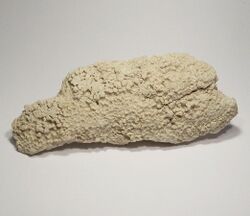Chemistry:Magadiite
From HandWiki
| Magadiite | |
|---|---|
 Magadiite. Collected in 1990 from Lake Magadi, Kajiado County, Kenya. | |
| General | |
| Category | Phyllosilicate |
| Formula (repeating unit) | NaSi7O13(OH)3·4(H2O) |
| Strunz classification | 9.EA.20 |
| Crystal system | Monoclinic Unknown space group |
| Space group | C2/m (no. 12) |
| Unit cell | a = 7.22 Å, b = 15.70 Å, c = 6.91 Å; β = 97.27°; Z=1 |
| Identification | |
| Color | White |
| Crystal habit | Minute platy crystals; spherulitic aggregates; powdery |
| Tenacity | Puttylike |
| Mohs scale hardness | 2 |
| |re|er}} | Vitreous - dull |
| Streak | White |
| Diaphaneity | Translucent to opaque |
| Specific gravity | 2.25 calculated |
| Optical properties | Biaxial |
| Refractive index | nα = 1.470 |
| Ultraviolet fluorescence | Yellow-white under both long and short wave |
| References | [1][2][3][4][5] |
Magadiite is a hydrous sodium silicate mineral (NaSi7O13(OH)3·4(H2O)) which precipitates from alkali brines as an evaporite phase. It forms as soft (Mohs hardness of 2) white powdery monoclinic crystal masses.[2][3] The mineral is unstable and decomposes during diagenesis leaving a distinctive variety of chert (Magadi-type chert).[7]
The mineral was first described by Hans P. Eugster in 1967 for an occurrence in Lake Magadi, Kenya, and is also found at Olduvai Gorge, Tanzania.[3][7] It is also reported from alkalic intrusive syenites as in Mont Saint-Hilaire, Canada .[2]
References
- ↑ Mineralienatlas
- ↑ 2.0 2.1 2.2 Mineral Handbook
- ↑ 3.0 3.1 3.2 Webmineral
- ↑ Mindat.org
- ↑ Garcés, Juan M. (1988). "Hypothetical Structures of Magadiite and Sodium Octosilicate and Structural Relationships Between the Layered Alkali Metal Silicates and the Mordenite- and Pentasil-Group Zeolites1". Clays and Clay Minerals 36 (5): 409–418. doi:10.1346/CCMN.1988.0360505. Bibcode: 1988CCM....36..409G.
- ↑ Warr, L.N. (2021). "IMA–CNMNC approved mineral symbols". Mineralogical Magazine 85 (3): 291–320. doi:10.1180/mgm.2021.43. Bibcode: 2021MinM...85..291W.
- ↑ 7.0 7.1 Encyclopedia of Sediments & Sedimentary Rocks, Springer, 2003, p. 417, ISBN:1-4020-0872-4
 |

